TRAVEL
When travelling to Lesvos you have 2 options. Option 1 is to travel by Olympus Air via Athens: this extends your travel time by several hours because you have to wait at Athens for the connecting flight. What it does give you however, is the opportunity of seeing the early migrants you may miss by travelling later. Option 2 is to take one of the direct charter flights which usually start in the first week in May: this gives a shorter flight and a more agreeable arrival time. Also Lesvos is fairly new to tourism and many of the resorts don’t get geared up for tourists until the direct flights start.
If you’re travelling to Lesvos independently I would recommend you get a taxi from the airport and have your hire car delivered to your hotel. Mytilini is a nightmare to find your way through; we have yet to see a sign in Mytilini that points to Skala. The airport is well signed on your return through Mytilini so you can elect to drop the car off at the airport if you so wish.
CAR HIRE
Hiring a car on Lesvos is simple as most of the major car hire companies are represented. You can hire a car through your Travel Agent, via the internet, at the airport or through your hotel. Car hire is, in the main, more expensive than on the continent with a grade 2 vehicle costing £300+ per week. Be prepared to shop around especially on the net because bargains do exist. It is possible to find one of the major hirers providing vehicles at 30% less than their rivals. Hertz is a company that regularly has bargain prices.
Be aware that insurance may not cover damage to the underside of the vehicle. This is mainly due to birders in the early days taking cars on roads that in reality were little more than dry river beds.
If you’re not totally satisfied with your hire car and have genuine reasons, complain immediately, this usually results in an upgrade at no extra cost.
LOCATION
The most important decisions you will make are where to base yourself, and when to go. To maximise the number of migrants seen I would recommend you go as early as direct flights will allow, mid/late April. If you are a serious birder and birding is the reason for your holiday then Skala Kalloni is your only choice. Skala is central for most birding sites but more importantly it is also very close to some of the major birding hot spots on the island. It would be possible to stay at Skala without hiring a car and still get in some serious birding. This can’t be said for any other part of the island. If birding were incidental to the holiday then I would recommend the north of the island where you will find a greater choice of accommodation.
Be aware that Lesvos is very popular with birders and photographers especially in spring so you are advised to book well in advance. It’s not uncommon for people to book up 12 months prior to departure.
WEATHER
The weather from April is usually fine with warm sunny days and evenings that may require a sweater slung over the shoulder. We may have been lucky during our visits but we have encountered little in the way of rain although it’s not uncommon to have a stiff breeze that will chill if you stand about in it too long.
EATING OUT
If you are self catering and I would recommend this for the serious birder, there are plenty of restaurants to choose from and you will soon find your own favourite. Be aware that if you go in early April not all the restaurants will be open and the ones that are may operate with a reduced menu. We can recommend the Sea Horse in Skala where we had good service, well cooked food, decent wine all at a very reasonable price.
All the hotels will also provide evening meals although in our opinion they are not to the standard you get in the restaurants, you will also find the choice of meals limited.
SELF-CATERING
Self-catering is probably the best option if you’re on a birding holiday as this gives you the flexibility of early starts & late finishes without worrying about meal times. Skala Kalloni has plenty of self-catering apartments and studios but beware, in the main, they are not of the standard you would normally expect in Western Europe.
We have yet to find a kettle at any of the apartments we have had, so if you like an early morning cuppa we would recommend you take a travel kettle especially if you chose to stay at one of the hotels.
The Greeks also tend to provide the bare minimum of both cooking utensils and cutlery so we restricted our cooking to breakfast after returning from early birding sorties.
Most of these early morning sorties culminated in our visit to one of the two bakeries in Scala Kalloni to stock up on fresh bread and pastries for the day ahead. The old one at the harbour makes bread in a traditional oven and is superb. The new one makes very acceptable bread and has a far greater choice of bread rolls and pastries. I would heartily recommend the apple turnovers from the old one if you can get them.
There are several general stores in Skala, which cater for most things but if you’re a more serious self-caterer then you may need to visit the supermarket, which is situated on the main road into Kalloni town and sells every thing you would expect from a supermarket.
Should you require cash this can be obtained from a cash point machine on the front in Skala near the harbour, instructions can be obtained in English. Credit cards are accepted at most places.
Should you hire a car and stop in Skala your nearest petrol station is on the main road adjacent to the salt pans. If you go to the birding spots to the north a petrol station is situated near the village of Agra
BIRDING

Birding on Lesvos has been popular with British birders for a dozen years or so and therefore all of the best birding spots are well documented. Love him or loathe him Richard Brooks bird watching guide to Lesvos is essential.
I have already mentioned early morning or late afternoon birding previously, at some sites this is essential because of the disturbance caused by unthinking birders and photographers and early morning means just that, pre 06.00am on site I’m afraid. To illustrate this I have seen both Little Crake & Spotted Crake at the Inland Lake every time when I have been there at first light I have yet to see either species once the birders start arriving at say 07.00am
You will soon find the back way to the salt pans from Skala, which will mean you will have to traverse the East River ford, this isn’t a problem at all, but you will be surprised at the number of vehicles that have strayed off the ford and got stuck in the river because the driver has been distracted by the birds.
Sites to visit
If you stay on Lesvos during April & May the visitors to the island will be predominantly birders and photographers so some disturbance to the birds is inevitable. I therefore suggest birding before breakfast and early evening tend to be most productive.
The summary of sites listed below is well documented in Richard Brooks Guide to Birding in Lesvos, together with location maps and directions.
Below is a personal account of the main birding sites:-
Kalloni 2 Pool
If you choose to stay at Skala Kalloni this pool is right on your doorstep and tends to be the first point of call each morning. The pool can be excellent for waders, terns, ducks and herons depending on the water level. Black-winged Stilts, Water Rail and Little Bittern all breed. Spur-winged and White-tailed Plover, Bittern and Garganey have all been seen during our visits.
Birds of note
Spur-winged Plover, Black Tern, White-winged Black Tern, Whiskered Tern, Bittern, Little Bittern, Purple Heron, White Stork, Black-winged Stilt, Garganey, Spotted Redshank, Water Rail.
Kalloni Salt Pans
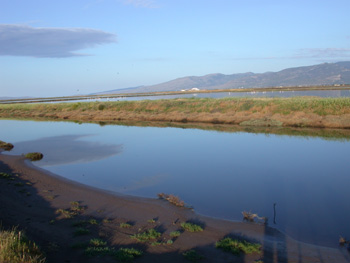
This area is excellent and probably the premier birding spot of the island for birding at any time, Be aware that disturbance can push the birds to the centre of the pans, it’s therefore best to bird from the car especially along the access road. Most birders will access the site by the metalled road leading to the main entrance. I suggest for early morning trips you go past the garage and turn right down a rather bumpy track, which accesses the rear of the pans. This means the sun is behind you making identification, especially at distance, far easier. The track is narrow but with a little care it was possible to turn around at the bottom when we were last there in 2001. You may find that other birders will note where you are and before to long you have company, which is fine as long as they park sensibly. For late afternoon and evening trips best views are from the access road.
Birds of note
Black Stork, Collard Pratincole, Stone Curlew, Red-necked Phalarope, Avocet, Spoonbill, Greater Flamingo, Mediterranean Gull, Slender-billed Gull, Gull-billed Tern, Caspian Tern, Common Tern, Little Tern, European Bee-eater, Rufous Bush Robin, Roller, Red-footed Falcon, Tawny Pipit.
East River
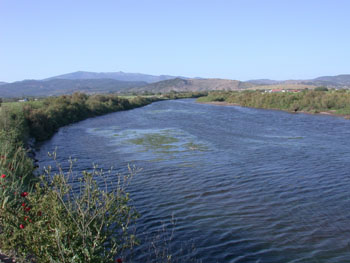
A drive or walk along the east river can be very rewarding. The area between the road bridge and the sea is very popular but don’t ignore the river above the bridge as this tends to be less heavily birded and some of the rarer birds have been found here. If you take the track on the left hand side of the bridge with the river on your right and turn left towards the silos and then right the track takes you past a smelly goat farm and up to an area, which will afford good views of the surrounding countryside. This has been a good area for raptors in the past.
Birds of note
Glossy Ibis, Great Snipe, Marsh Sandpiper, Night Heron, Squacco Heron, Ruddy Shelduck, Rufous Bush Robin, Golden Oriole, Black-headed Bunting, Citrine Wagtail.
West River
Although not to be ignored, I have found the west river to be the least productive of the sites around Skala Kalloni, although we did see our first Red-throated Pipits there on our first morning.
Inland Lake
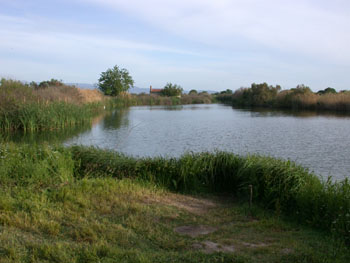
Richard Brooks recommends you stay in your vehicle when you visit this site as your target birds, Spotted Crake, Little Crake and several of the Heron family will disappear at the slightest disturbance. This is sound advice not acted on by many birders so my advice is to visit this site either at the crack of dawn or mid to late evening when most of the birders will be feeding their faces.
Birds of note
Spotted Crake, Little Crake, Night Heron, Purple Heron, Alpine Swift.
Parakila Marshes
During my visits to these marshes I have found little of ornithological interest. My advice is to take a cursory glance as you drive slowly past.
Devil’s Bridge
The small chapel at Parakila referred to in Brooks’s book as Devil’s Bridge is well worth exploring especially the ravine to the rear, this has produced many good birds in the past. As this area can be affected by disturbance my advice is either an early morning / late afternoon visit or stop if there are only a couple of parked cars.
Birds of note
Rock Nuthatch, Sombre Tit, Cinerious Bunting, Ortolan Bunting, Red-backed Shrike. Lesser Whitethroat, Blue Rock Thrush.
Agra Round House
I am not sure if Richard refers to this in his book or not. The term, round house, is used by me to describe a large stone built circular building adjacent to the road as you leave Agra.
Birds of note
Rock Sparrow, Little Owl, Rock Nuthatch, Red-rumped Swallow, Alpine Swift.
Ipsilou Monastery
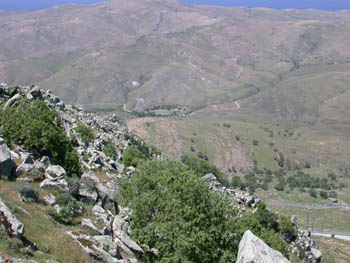
Another excellent birding spot, I suggest, if you feel confident, drive up the steep metalled road and park at the car park adjacent to the monastery. You can walk through the main courtyard to a large wooden door at the rear, this allows access to the rear of the monastery and lets you look down from an elevated position on the adjacent trees, which tend to attract many migrants. The alternative is to view at ground level which means looking up through the canopy affording restricted viewing.
Birds of note
Long-legged Buzzard, Lesser Kestrel, Peregrine Falcon, Alpine Swift, Whinchat, Isabelline Wheatear, Red-breasted Flycatcher, Collared Flycatcher, Rock Sparrow.
Petra lay-by
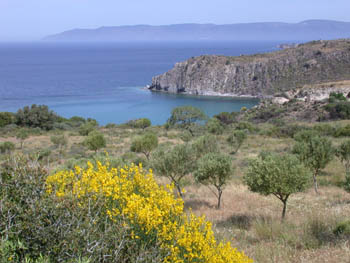
This area is a recognised site for Ruppell’s Warbler, which tend to be seen on the seaward side of the road, although I have encountered them on the landward side too. The area that is not so well documented is the track on the opposite side of the road that takes you up into a hilly area of scrub. This is an excellent area for warblers.
Birds of note
Ruppell’s Warbler, Subalpine Warbler, Olivacious Warbler, Lesser Whitethroat, Pied Flycatcher, Blackcap, Lesser Kestrel, Northern Wheatear
Faneromeni Ford
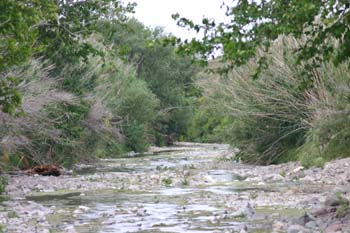
A personal favourite of mine. This is an excellent area for warblers and heron species, It was a favourite picnic lunch spot for us, especially if you can park the car in the shade of the reeds. Be aware that vehicles do use the ford so leave room for them to pass.
Birds of note
Citrine Wagtail, Nightingale, Olivacious Warbler, Icterine Warbler, Orphean Warbler, Little Bittern, Squacco Heron, Night Heron.
Potamia Valley
The olive groves at the entrance to the valley and en route to the inland lake are superbly carpeted with wild flowers in spring, and a haven for many of the island’s passerines. It’s also the nearest documented site for Olive-tree Warbler to Skala. I have to confess that I have never been able to justify the time to search out this rather elusive bird when there’s so many colourful birds far more confiding. 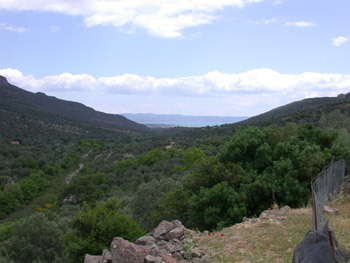 As you climb up through the valley, vantage points are apparent where many of the island’s Raptors can be seen. One of these is known as Frances’s camp, which can be reached by way of a rough track that leads from the main track adjacent to the reservoir.
As you climb up through the valley, vantage points are apparent where many of the island’s Raptors can be seen. One of these is known as Frances’s camp, which can be reached by way of a rough track that leads from the main track adjacent to the reservoir.
Birds of note
Red-backed Shrike, Lesser Grey Shrike, Woodchat Shrike, Masked Shrike, Tree Sparrow, Cirl Bunting, Collared Flycatcher, Bee-eater, Short-toed Tree-creeper, Golden Oriole.
Other Sites
There are several other good birding sites referred to in Brooks’s guide such as Derbyshire and the Napi Valley. I find very little to add to what is in the guide.
There is however a marsh referred to as Dipi Larssos and some Salt Pans in the south of the islands. I would suggest you only visit these sites when you have exhausted all the recognised sites, or if you receive reports of good birds being present. Dipi Larssos however does usually hold both Reed & Great Reed Warbler and occasionally Marsh Sandpiper, so if you need either for your trip list a visit could be included with a trip to Derbyshire.
Bird List
- LITTLE GREBE Tachybaptus ruficollis 2 birds on the East River 28th, 1 bird Inland Lake 29th, 2 at the same venue 3rd & 4th May.
- CORY’S SHEARWATER Colonectris diomedea Hundreds of birds moving west, close inshore between Petra & Molivos.
- CORMORANT Phalacrocorax carbo Odd birds around the coast.
- SHAG Phalacrocorax aristotelis Odd birds on the coast, 5 fishing in the bay at Parakila.
- LITTLE BITTERN Lxobrychus minutes 1 female Kalloni pool 24th, 1 male on the East River 26th, male & female gave great views at Faneromeni ford on the 30th. 4 males & 2 females were encountered at the inland lake during a pre-breakfast visit.
- NIGHT HERON Nyctricorax nyctricorax Only 2 sightings for the trip, both male birds: 1 on a small watercourse near Andissa, and 1 at the inland lake.
- SQUACCO HERON Ardeola ralloides Birds encountered most days peaking to 4 birds on the Upper East River, and 3 at the Kroussos Ford on 4th May.
- LITTLE EGRET Egretta garzetta Birds common at suitable habitats.
- GREAT WHITE EGRET Egretta alba Sightings were confined mostly to the saltpans, although 1 bird was seen in the bay near Derbyshire. Singletons most days with 3 at the salt pans May 2nd .
- GREY HERON Ardea cinerea Birds seen at suitable locations, a flock of 27 seen flying high over the salt pans on 29th April.
- PURPLE HERON Ardea purpurea 1 bird flew into the field at the rear of the inland lake on 24th. 3 roosting in the Tamarisk at the same venue, on 3rd May.
- GLOSSY IBIS Plegadis falcinellus Birds encountered most days, with 29 on the East River on 26th . Numbers had reduced to a handful by the beginning of May.
- BLACK STORK Ciconia nigra Single birds were seen on no fewer than 9 days. Most sightings were on or around the East River. Other sightings were at the saltpans.
- WHITE STORK Ciconia ciconia Small numbers of birds were seen on all but 1 day of the trip. Most sightings were concentrated in or around Kalloni 2 pool.
- SPOONBILL Platalea leucorodia A single bird was present throughout the trip on the saltpans feeding with the Flamingos.
- GREATER FLAMINGO Phoenicopterus ruber Approximately 4/500 birds were present on 22nd . This number had halved by 4th May.
- SHELDUCK Tadorna tadorna Odd birds especially at the rear of the salt pans.
- RUDDY SHELDUCK Tadorna ferruginea Birds, usually in pairs, were encountered on 22nd, 23rd, 26th, 28th April and 4th May. A flock of 37 was seen on the wetland between Kalloni saltpans and Derbyshire.
- GARGANEY Anas querquedula Pairs of birds were seen at the following locations, Potamia reservoir 26th, East River 28th, 29th, 5 were present at Kalloni pool 2nd & 3rd May.
- SHOVELER Anas clypeata A flock of between 10-20 birds were observed at the Kalloni saltpans unto 26th April. No birds seen after that date.
- MARSH HARRIER Circus aeruginosus Singletons were present at both the Kalloni saltpans and the West River on each visit. All birds observed were female.
- HEN HARRIER Circus cyaneus Only ring-tails were seen, East River 22nd, 23rd, Derbyshire 25th, Saltpans 28th April & 4th May.
- MONTAGU’S HARRIER Circus pygargus 1 female flew along the ridge behind the chapel at Devil’s Bridge 27th April.
- BUZZARD Buteo buteo Common at suitable locations.
- LONG-LEGGED BUZZARD Buteo rufinus A pair display flying at Ipsilou Monastery 23rd, Devil’s Bridge 30th, Kalloni saltpans 1st, Napi Valley 2nd, and Potamia Valley 3rd.
- BOOTED EAGLE Hieraaetus pennatus 1 male (pale form) Potamia Valley 22nd April.
- SHORT-TOED EAGLE Circaetus gallicus 1 male Derbyshire 25th, 1 male Potomia Valley 28th.
- LESSER KESTREL Falco naumanni Small parties of up to 6 birds between Sigri & Andissa 23rd & 27th, 2 birds Faneromeni Ford 27th.
- KESTREL Falco tinnunculus Birds common at all suitable habitats.
- RED-FOOTED FALCON Falco vespertinus First birds seen at the Kalloni saltpans on 25th April. Small flocks then encountered every day until 2nd May.
- ELEONORA’S FALCON Falco eleonorae Only bird seen, 1 male between Agra & Mesotopos 4th of May.
- PEREGRINE FALCON Falco peregrinus 1 bird between Petra & Molivos 24th, 1 bird hunting over the salt pans 30th & 1 bird at the Napi Valley 1st May.
- CHUKAR Alectoris chukar 1 bird between Eressos & Andissa 23rd , 2 birds seen Mesotopos & Kroussos.
- LITTLE CRAKE Porzana parva 2 birds encountered during an early morning visit to the Inland Lake on 3rd May.
- MOORHEN Gallinula chloropus Birds common at all suitable locations.
- COOT Fulica atra Only record was a singleton on the Potamia Valley reservoir 29th April & 3rd May.
- BLACK-WINGED STILT Himantopus himantopus Common breeding wader present at all suitable habitats.
- AVOCET Recurvirostra avosetta Breeding population of 50 – 100 pairs. Birds seem to be restricted to the saltpans.
- STONE CURLEW Burhinus oedicnemus Birds located at the saltpans from 25th April-4th May. Nesting pair badly disturbed by photographers.
- COLLARED PRATINCOLE Glareola pratincola 9 birds loafing on a mud spit at Kalloni saltpans 22nd, only other sighting was a single bird at the same venue on the 29th.
- LITTLE-RINGED PLOVER Charadrius dubius Birds seen at all suitable locations.
- RINGED PLOVER Charadrius hiaticula Again small numbers at suitable locations.
- KENTISH PLOVER Charadrius alexandrinus Common breeder on the island.
- GREY PLOVER Pluvialis squatarola 11 birds in various stages of summer plumage were at the saltpans 26th – 30th.
- SANDERLING Calidris alba 2 birds present at Kalloni saltpans 29th.
- LITTLE STINT Calidris minuta Common wader with flocks of 50> not uncommon.
- TEMMINCK’S STINT Calidris temminckii 1 bird present on a small pool outside Skala on 1st May with 3 at the same venue on 2nd.
- CURLEW SANDPIPER Calidris ferruginea 9 birds present at the saltpans on 26th-30th April with 14 at the same venue from 1st – 4th May.
- RUFF Philomachus pugnax A very common wader with 50> at suitable locations.
- COMMON SNIPE Gallinago gallinago A singleton observed flying from Kalloni pool 2nd.
- GREAT SNIPE Gallinago media This bird was located on the upper East River on 2nd. It was thought to be the same bird seen on the lower East River 3 weeks previously.
- BLACK-TAILED GODWIT Limosa limosa Just 2 birds present at the saltpans on 29th & 2nd May.
- SPOTTED REDSHANK Tringa erythropus Only sighting was 2 birds between Kalloni & Derbyshire on 28th.
- REDSHANK Tringa totanus Single birds seen most days at suitable sites.
- MARSH SANDPIPER Tringa stagnatilis Up to 7 birds present on the upper East River on 28th, 29th April & 1st & 4th May.
- GREENSHANK Tringa nebularia Odd birds only seen during the trip.
- GREEN SANDPIPER Tringa ochropus Only 2 sightings of single birds, both on the saltpans. 1 on 22nd & 1 on 24th.
- WOOD SANDPIPER Tringa glareola A very common wader with birds at all suitable sites.
- COMMON SANDPIPER Actitis hypoleucos All suitable habitats contained several birds.
- TURNSTONE Arenaria interpres 2 birds on the saltpans 29th & 30th.
- MEDITERRANEAN GULL Larus melanocephalus 2 birds in full breeding plumage present on the saltpans on 25th.
- LITTLE GULL Larus minutus 9 birds seen feeding on the seaward side of the breakwater at Skala Sikimmia 24th. Singletons at the saltpans on 26th April & 1st May.
- BLACK-HEADED GULL Larus ridibundus 1 bird only with Little Gull on the saltpans.
- SLENDER-BILLED GULL Larus genei 5 birds at saltpans 25th & 26th.
- YELLOW-LEGGED GULL Larus cachinnans Birds abundant at suitable locations.
- GULL-BILLED TERN Gelochelidon nilotica A single bird at the saltpans for the duration joined by 2 more on 26th with 2 birds present on 4th .
- CASPIAN TERN Sterna caspia A single bird was using the saltpans as over-night roost from 28th, usually arriving between 18.30–19.00.
- SANDWICH TERN Sterna sandvicensis 8 birds present at the saltpans on 28th.
- COMMON TERN Sterna hirundo As its name suggests, the commonest tern of the trip with 50> birds ever present usually at the Kalloni pool & saltpans.
- LITTLE TERN Sterna albifrons The second most common tern with several dozen present at the saltpans.
- BLACK TERN Chlidonias niger Several birds feeding with other terns at the saltpans 30th April & 2nd May.
- WHITE-WINGED BLACK TERN Chlidonias leucopterus Birds present at the saltpans on 25th, 29th, 30th April also on 2nd, 3rd, & 4th May, numbers peaked at 15. 5 present at Kalloni pool.
- WHISKERED TERN Chlidonias hybridus Small numbers seen peaking to 11 on 3rd.
- CUCKOO Cuculus canorus Although regularly heard, birds were seen on only 4 occasions.
- ROCK DOVE Columba livia A small colony on the island off Skala Eressos .
- WOOD PIGEON Columba palumbus Only 1 bird seen at Potamia Valley 22nd.
- COLLARED DOVE Streptopelia decaocto Common at all locations.
- TURTLE DOVE Streptopelia turtur First seen on 27th then daily thereafter.
- BARN OWL Tyto alba Birds observed at their traditional nesting site in the old disco building in Skala Kalloni. Possible different bird seen on the road to the old town of Kalloni.
- LITTLE OWL Athene noctula The commonest and only other owl seen, with birds seen all over the island. Birds usually associated with old farm buildings.
- COMMON SWIFT Apus apus A common passage migrant with small numbers seen most days.
- ALPINE SWIFT Apus melba Small numbers were seen 23rd, 24th, above Agra & Molivos respectively. Birds were seen using the Potamia reservoir for a drink 30th.
- ROLLER Coracias garrulus Birds were observed on 3 occasions, 1 at the track between the East River and saltpans 28th, 1 at the saltpans 30th & 1 at Kroussos on 4th May.
- BEE-EATER Merops apiaster Birds were present at the usual sites. A flock of 43 was seen passing through the Napi Valley .
- HOOPOE Upupa epops Sightings on 5 occasions, the most memorable was birds feeding well grown chicks in the Napi Valley 22nd April.
- MIDDLE SPOTTED WOODPECKER Dendrocopos medius A pair was feeding young in a dead tree at Skala Kalloni. Birds observed at Devil’s Bridge & Napi Valley .
- SHORT-TOED LARK Calandrella brachydactyla The only location birds seen was Kalloni saltpans on 22nd, 26th April & 1st May.
- LESSER SHORT-TOED LARK Calandrella rufenscens 2 birds at Kalloni saltpans 1st & 4th May.
- CRESTED LARK Galerida cristata Birds abundant over the whole island.
- WOODLARK Lullula arborea 1 bird observed display flying above the Kruper’s site, Derbyshire 28th.
- SAND MARTIN Riparia riparia Birds very common, passing through the island in large numbers most days.
- HOUSE MARTIN Delichon urbica Very common, large numbers of both passage birds & summer visitors building nests.
- CRAG MARTIN Ptyonoprogne rupestris A small colony of birds at 2 locations in the Grand Canyon .
- SWALLOW Hirundo rustica The most common Hirundine of the area.
- RED-RUMPED SWALLOW Hirundo daurica Birds encountered every day with birds nesting at suitable locations.
- TAWNY PIPIT Anthus campestris 2 birds Kalloni saltpans 29th April & 1st May
- RED-THROATED PIPIT Anthus cervinus Fair numbers of birds on the West River from 22nd – 24th. Singleton at the saltpans 28th & 1 on the wires on the track between the East River and the saltpans.
- WHITE WAGTAIL Motacilla alba Odd birds seen throughout the trip.
- YELLOW WAGTAIL Motacilla flava Birds of most races seen at suitable locations during the trip.
- CITRINE WAGTAIL Motacilla citreola An obvious influx into the island was evident on 30th April & 1st May. A pair was present at Kroussos Ford. 3 males & a female were at Tavari . A pair with a sub-adult were on the upper East River on 1st.
- RUFUS BUSH ROBIN Cercotrichas galactotes The 1st bird was encountered near Faneromeni on 27th. A male was present on the track to Kroussos on 30th and observed displaying on a boulder at the same venue on 1st May. A bird was also present at the saltpans 3rd.
- ROBIN Erithacus rubecula Only sighting was in the chestnut woods above Agiassos.
- NIGHTINGALE Luscinia megarhynchos Abundant at all suitable habitats.
- COMMON REDSTART Phoenicurus phoenicurus Only 1 sighting, a male at Faneromeni on 27th.
- WHINCHAT Saxicola rubetra Common at suitable locations.
- STONECHAT Saxicola torquata Single birds seen on 23rd, 27th, & 28th.
- BLACK-EARED WHEATEAR Oenanthe hispanica Very common especially in the west of the island.
- ISABELLINE WHEATEAR Oenanthe isabellina Birds seen on each visit to the well known site between Sigri & Andissa.
- NORTHERN WHEATEAR Oenanthe oenanthe Only 1 bird seen at the East River on 22nd.
- BLUE ROCK THRUSH Monticola solitarius A common resident.
- BLACKBIRD Turdus merula Abundant throughout the island.
- MISTLE THRUSH Turdus viscivorus 2 sightings at the chestnut woods above Agiassos.
- FAN-TAILED WARBLER Cisticola juncidis 1 bird displaying on the West River .
- CETTI’S WARBLER Cettia cetti A very common warbler on the island.
- MOUSTACHED WARBLER Acrocephalus melanopogon A male present at Kroussos Ford.
- SEDGE WARBLER Acrocephalus schoenobaenus Birds present at the West River on 2nd.
- MOUSTACHED WARBLER Acrocephalus melanopogon A male present at Kroussos Ford. 4th, and at Kroussos on 30th.
- REED WARBLER Acrocephalus scirpaceus Several birds present at Dipi Larssos 28th. Also the saltpans on 2nd. Birds also at the Potamia River on 3rd.
- GREAT REED WARBLER Acrocephalus arundinaceus 1 bird singing on the track between the East River & the Kalloni saltpans, 25th. 2 birds present Dipi Larssos 28th.
- OLIVACEOUS WARBLER Hippolais pallida A common warbler at all suitable habitats.
- ICTERINE WARBLER Hippolais icterina 1 bird present at the Faneromeni ford on 30th.
- SUBALPINE WARBLER Sylvia cantillans Several birds present adjacent to the second lay-by between Petra and Molivos. A male bathing in the Potamia valley on 26th, Napi Valley on 2nd & Grand Canyon on 3rd.
- RUPPELL’S WARBLER Sylvia rueppelli 2 males encountered up the track behind the 2nd lay-by on the road between Petra & Molivos on 24th.
- ORPHEAN WARBLER Sylvia hortensis 2 sightings both adjacent to the Faneromeni ford, 1st on 1st May, 2nd on 4th May.
- LESSER WHITETHROAT Sylvia curruca 2 birds present at Faneromeni ford on 30th.
- WHITETHROAT Sylvia communis Small numbers of birds encountered 22nd, 24th, 25th & 26th.
- BLACKCAP Sylvia atricapilla Similar to Whitethroat, small numbers encountered on 23rd, 24th, 27th & 30th. All but the 30th sighting were in the north of the island.
- WOOD WARBLER Phylloscopus sibilatrix 3 birds were present at the 1st ford on the track to Kroussos on 30th.
- CHIFFCHAFF Phylloscopus collybita 1 bird was seen singing at the Kruper’s site in Derbyshire.
- WILLOW WARBLER Phylloscopus trochilus 1 bird at Ipsilou on 23rd, 2 birds at Kroussos ford on 30th.
- SPOTTED FLYCATCHER Muscicapa striata Small number of birds at many suitable locations. Birds seen on 23rd, 24th, 26th, 30th April & 1st, 2nd and 4th May.
- RED-BREASTED FLYCATCHER Ficedula parva 1 bird flew down and walked under the car at the Rock Thrush site at the Grand Canyon on 23rd.
- COLLARED FLYCATCHER Ficedula albicollis 1 bird present at the Grand Canyon on 23rd and 1 at the 2nd lay-by near the disco.
- PIED FLYCATCHER Ficedula hypoleuca Although not plentiful, birds were seen on 27th, & 30th April, and 1st, 2nd & 4th May.
- SOMBRE TIT Parus lugubris Birds seen at most suitable locations.
- BLUE TIT Parus caeruleus Birds encountered on most days, with upland areas being preferred.
- GREAT TIT Parus major The commonest of all the tits with birds seen most days.
- KRUPER’S NUTHATCH Sitta krueperi A fleeting glimpse of a feeding bird at the recognised site in Derbyshire.
- ROCK NUTHATCH Sitta neumayer Birds common at all suitable upland sites.
- SHORT-TOED TREECREEPER Certhia brachydactyla 2 adult birds feeding fledglings at the Kruper’s site 25th. Only other sighting Derbyshire on 28th.
- GOLDEN ORIOLE Oriolus oriolus A male in the Potamia Valley on 22nd. 1 male singing above the East River & a male over the track to Kroussos ford.
- RED-BACKED SHRIKE Lanius collurio The second most common shrike of the area.
- LESSER GREY SHRIKE Lanius minor Birds encountered at the following sites, Potomia Valley , Derbyshire & the Grand Canyon.
- WOODCHAT SHRIKE Lanius senator The commonest shrike of the region.
- MASKED SHRIKE Lanius nubicus The first bird was not encountered until 29th, after which there were several sightings at the East River, Napi Valley and the Potamia Valley.
- JAY Garrulus glandarius Birds common at suitable sites.
- JACKDAW Corvus monedula A small colony was present at Sigri and the only birds seen.
- HOODED CROW Corvus corone cornix Very common corvid.
- RAVEN Corvus corax 2 birds present Potamia valley 22nd and the Grand Canyon on 27th.
- HOUSE SPARROW Passer domesticus Abundant.
- SPANISH SPARROW Passer hispaniolensis Small nesting colonies were seen throughout the Island, with most around Skala Kalloni.
- TREE SPARROW Passer montanus 1 male was present with the Spanish Sparrows.
- CHAFFINCH Fringilla coelebs Birds common where mature trees are present.
- SERIN Serinus serinus 4 birds present at the Kruper’s site 23rd & 25th. A male in Derbyshire 28th.
- GREENFINCH Carduelis chloris Birds very common.
- GOLDFINCH Carduelis carduelis The commonest finch of the region.
- LINNET Carduelis cannabina Common at suitable sites.
- CIRL BUNTING Emberiza cirlus Small numbers encountered in valleys with scattered trees.
- CINEREOUS BUNTING Emberiza cineracea Not common, but an accommodating male sang from the top of the conifers at the chapel in Devil’s Bridge each time we visited.
- ORTOLAN BUNTING Emberiza hortulana 1 male present at Agra 23rd, and at Molivos on 24th.
- CRETZSCHMAR’S BUNTING Emberiza caesia Birds fairly common at suitable locations.
- BLACK-HEADED BUNTING Emberiza melanocephala First birds arrived on 25th, the island then seemed full of birds.
- CORN BUNTING Miliaria calandra By far the commonest bunting with most overhead wires holding birds.
